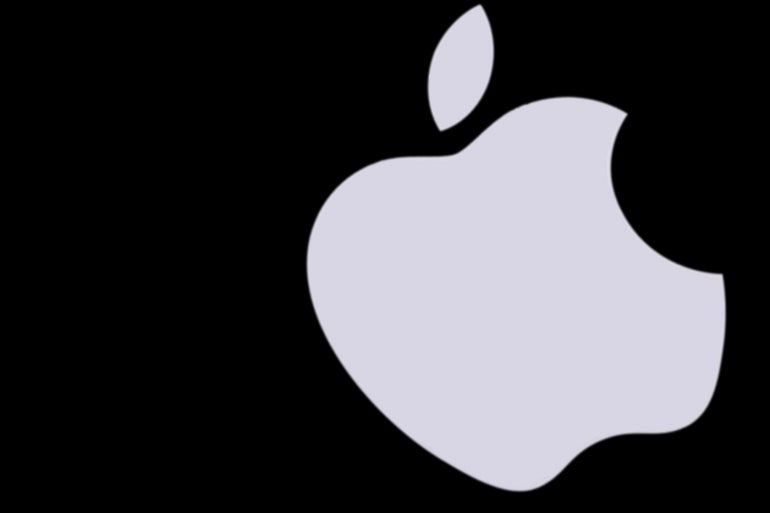The new macOS, version 13 of the operating system announced by Apple at WWDC 2022, introduces many new features and innovations. This cheat sheet explores important new capabilities as well as requirements for the new operating system named macOS Ventura. This macOS 13 Ventura cheat sheet describes the new operating system’s innovations and enhancements, lists the devices capable of running the new release, and details how and when Mac users can access the new release.
SEE: Best Password Managers for Mac and iOS (TechRepublic)
Jump to:
- What is macOS 13 Ventura?
- What are the main features of macOS Ventura?
- Which devices support macOS 13 Ventura?
- When is the release date for macOS 13 Ventura?
- How to download and install macOS 13 Ventura
What is macOS 13 Ventura?
The 13th version of the Mac operating system, known as macOS Ventura, is designed for contemporary Mac laptop and desktop computers. Enhancements and innovations within the new release strive to assist Mac users in collaborating, creating, organizing and producing documents, presentations, creative material and more. Core task improvements, such as for email and search, are included within the new release to better enable Mac users routinely throughout the workday.
Announced during Apple’s annual WWDC keynote speech, the company made light of its naming conventions, which have become a popular topic among developers and others who attend the show each year. Apple VP Craig Federighi joked the company’s crack marketing team required a three-month rejuvenation retreat before selecting the new Ventura moniker.
SEE: iOS 16 cheat sheet: Complete guide for 2022 (TechRepublic)
More importantly, Federighi confirmed Apple’s developers focused on improving core functions Mac users frequently rely upon in this new macOS release (Figure A). The features are particularly poignant, as they leverage enhancements made possible in part by innovations with Apple silicon chips that are increasingly replacing older Intel components that previously powered Macs. New Apple Mac M2 circuitry was also announced at WWDC 2022.
Figure A
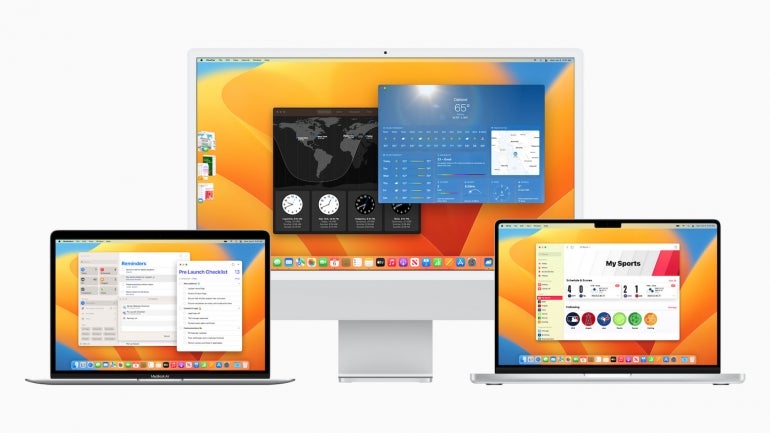
What are the main features of macOS Ventura?
Stage Manager
Window management features are becoming increasingly important, as Mac users more commonly juggle multiple applications simultaneously, such as often occurs when managing projects, coordinating plans and producing content. While Mission Control plays a key role in helping Mac users view all active windows, sometimes too many options and choices prove available.
SEE: How to use Mission Control to optimize macOS operation (TechRepublic)
Stage Manager assists focusing on the app you’re actively using without distractions. Activated from Control Center, Stage Manager automatically arranges all windows off to the side (Figure B), placing the current app front and center.
Figure B
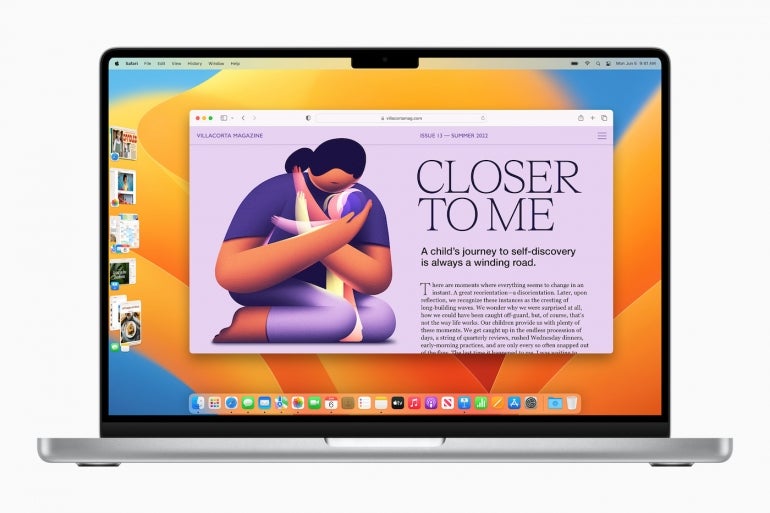
Clicking on thumbnail icons macOS places on the left-hand side of the screen prompts macOS to switch to that group of apps, with the most recently used appearing on top. Grouping apps is simple: macOS Ventura users can drag-and-drop apps on top of one another to group them together.
When working with an iPad, macOS Stage Manager also permits multitasking in a new way. Thanks to full external display support, macOS Ventura users can drag apps and windows between iPadOS 16 and macOS Ventura devices. The new feature simplifies common administration, planning and management workflows, adding additional convenience to the Mac desktop.
Spotlight enhancements
With the goal of delivering a more consistent experience across multiple devices, Mac’s Spotlight search feature is receiving an upgrade in macOS Ventura. Using the new macOS release, Mac users can steal a peak at individual search results using Quick Look, activated with a quick tap of the spacebar (Figure C).
Figure C
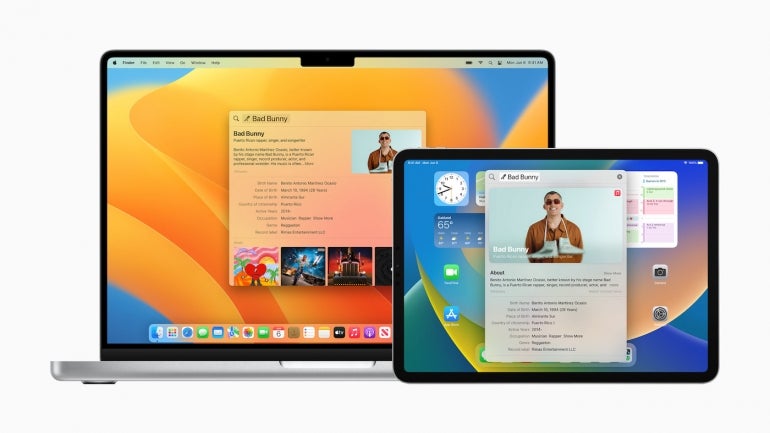
Spotlight’s search capabilities have been improved too. Spotlight can now search within the Photo Library and images. The search function also supports running shortcuts from directly within Spotlight, making locating specific items and acting quickly on the results more natural and fluid.
Mail improvements
An essential application, the macOS email client Mail receives many important new features with the Ventura release. Mac users can now recall (undo send) a sent email message. Using Ventura, the popular mail application also supports scheduling sending messages at later times, while also providing automatic follow up suggestions, such as when you haven’t received a response to a previous emailed request.
SEE: Microsoft Outlook vs. Apple Mail: Which email client is best for business? (TechRepublic)
macOS Ventura users will find Mail’s integrated search is improved, too, with suggested search terms appearing as soon as typing begins within the search box. Mail’s enhanced search engine also better detects recently shared documents, links, attachments and other elements. The refined Mail search automatically corrects for misspellings within macOS Ventura and provides more accurate and complete results than before as well.
Shared Tab Groups
Safari, the web browser integrated within macOS, remains the fastest and most energy-efficient web client for the Mac. With the macOS Ventura release, Safari receives an upgrade, too.
SEE: Safari refinements justify setting the browser as default in macOS Big Sur (TechRepublic)
Beginning with Ventura, Apple introduces Shared Tab Groups (Figure D). The feature permits assembling a collection of tabs and links, such as when researching a particular challenge or specific event, and sharing those tab groups with coworkers the user chooses.
Once shared, recipients can add their own tabs and links to the Shared Tab Group, enhancing collaboration and team work even when working remotely or from multiple locations.
Figure D
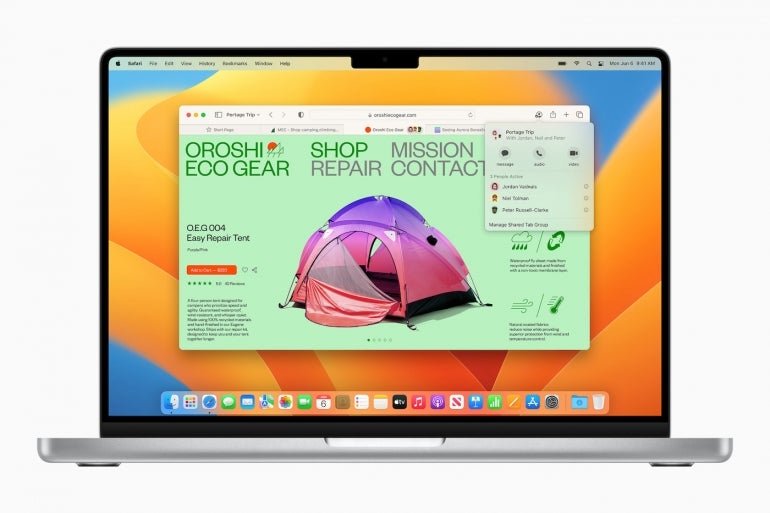
PassKey
There’s another important new feature included in macOS Ventura, too, for Safari. The introduction of the next-generation security credential, known as PassKey, changes the way macOS users log into sites and access sensitive information (Figure E).
Figure E

Using powerful cryptographic techniques and biometric information enabled by Apple devices, including Touch ID and Face ID, users receive a more secure and easier way to verify their identity. The feature creates a unique digital key for use on just a single site. And, because the PassKey data doesn’t live on the website, the credential can’t be obtained by phishing attempts or leaked by a compromised website. Securely synchronized across a user’s Apple devices using Keychain, the PassKey innovation, integrated within Safari, begins a shift away from using traditional passwords in order to safeguard account credentials.
FaceTime Continuity
Many Mac users likely proclaimed “Finally!” after hearing the WWDC 2022 announcement confirming macOS Ventura will introduce FaceTime Continuity, or the ability to hand off an active FaceTime conference from an iPhone to a Mac.
SEE: How to share content over FaceTime with SharePlay in iOS 15.1 (TechRepublic)
Subsequently, users can begin a FaceTime call on their iPhone or iPad then, when in close proximity to their Mac, move the call to the Mac in order to take advantage of the Mac’s larger display and free their hands from potentially having to hold the phone. All the user needs to do is click a green Switch button that appears on the Mac running Ventura.
Continuity Camera
Another timely feature included with macOS Ventura is Continuity Camera, which permits using an iPhone camera as a webcam (Figure F). Working with Belkin, Apple’s also designed elegant mounts that can be placed atop a Mac display to hold the iPhone.
Figure F

The technology works wirelessly, so there’s no need to tether the iPhone to the Mac using a cable. The Mac instead automatically detects the iPhone when the iPhone is near the Mac.
Because Center Stage keeps the speaker within the center of the frame, the new feature is particularly helpful when the user requires some movement or there are multiple attendees speaking.
SEE: This is the most effective Apple mobile device management service (TechRepublic Academy)
The Continuity Camera boasts other enhancements, too, including Portrait Mode, which blurs the background to emphasize the user, and Studio Light, which assists difficult lighting conditions by lightening the user’s face while darkening the background, similar to the effect that occurs when using a separate ring light.
Continuity Camera’s innovations don’t end there. The macOS Ventura enhancement also includes a new Deskview feature in which, using an iPhone’s ultra-wide camera and powerful image processing, objects sitting on the user’s desk can be shown alongside the user within the FaceTime window.
Also compatible with Zoom, Teams and Webex meetings, Deskview mimics a dedicated overhead camera and enables displaying designs, sketches, diagrams and other objects placed on the user’s desk.
Which devices support macOS 13 Ventura?
The rise and popularity of Apple’s powerful and energy conserving M1 and M2 silicon chips have one downside: Many believe the new chips inevitably will make it more difficult for Apple developers to continue accommodating older hardware and enabling older Macs to run new versions of the Mac’s operating system. Because the CPU, GPU and memory architecture and performance are so integral to a system’s capabilities and security, it’s possible older Intel-based systems could become outdated more quickly.
SEE: M1 MacBook Pro 2021: Which laptop model is right for you? (TechRepublic)
That said, many older Macs, including some Intel-powered versions, and newer M1-powered systems prove compatible with the 13th macOS, Ventura, including:
- 2017 and later iMac
- 2017 and later MacBook
- 2017 and later MacBook Pro
- 2017 iMac Pro
- 2018 and later MacBook Air
- 2018 and later Mac mini
- 2019 and later Mac Pro
- 2022 Max Studio
When is the release date for macOS 13 Ventura?
The developer beta for macOS Ventura is available to members of Apple’s Developer Program beginning June 6, 2022. The public beta for macOS Ventura became available in July 2022. The final full release is planned for fall 2022.
How to download and install macOS 13 Ventura
Members of Apple’s Developer Program can download the developer beta directly from Apple. Users can download the public beta scheduled for July from Apple’s beta site, once it’s ready, while the full fall release will be made available as a free software update accessible from within macOS System Preferences’ Software Update applet.
